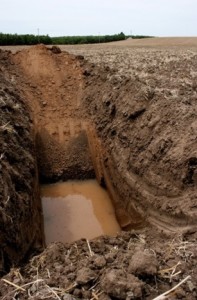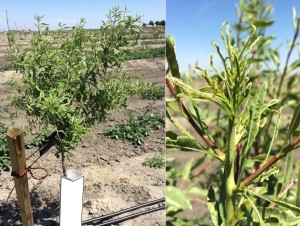When planning a new orchard, it is important to consider location, water availability and quality, irrigation system selection, pre-plant soil modification, rootstock, and variety selection. Mistakes made during the planning process will be present throughout the orchard’s life. Below are some considerations to keep in mind when selecting a site, rootstock, and variety.
Site selection and modification.

Soil type. Soils that have a high water holding content can be problematic when trying to access the orchard in early spring. Furthermore, these soils may also increase the risk of “wet feet” and Phytophthora infections. Rocky soils can make orchard operations like harvesting and mowing challenging, but generally can be managed unless it is more rocks than soil. Saline-alkaline soils will have challenges with water infiltration. These soils often require pre-plant leaching or modification to leach salts.
Salinity. Soil salinity should be below1.5 dS/m as an average of the rooting depth (five feet). To determine the salt levels, soil samples should be collected from each of the differing soil types in the field.. Sample plugs or auger cores of each soil type in 4-5 locations. At each location, sample every 12 in of depth to 60 in. Combine and pool samples at a given depth (e.g. combine and mix 4-5 samples at 12 in depth, 4-5 samples at 24 in depth etc). A composite sample should be pulled for every 20 acres, with a minimum of three samples for smaller fields.
Nematodes. When soil sampling for salinity and soil nutrients, set aside some of the soil from the 12-24” depth samples for nematode analysis. Submit the soil to a lab that can test for nematodes. For almond and other stonefruit, nematodes of concern are ring, root lesion, and rootknot. If counts are greater than 50 per liter (or 500 grams) of soil for root lesion and rootknot, or 25 for ring, contact the local UC Cooperative Extension farm advisor for specifics on pre-plant soil treatment options. Some common species of root lesion nematodes feed primarily on weeds and are of little concern to almond growers. Therefore you must request that the lab identify which species of root lesion is present.
Water source. The source of irrigation should be considered when planting. This includes the quality and quantity. Ideally, water should be less than 1.0 dS/M in EC, with a sodium adsorption ration (SAR) less than 3, chloride under 5 meq/L, and boron under 0.5 mg/l (0.5 ppm). Water pH should be 7.2 or less, and may need to be amended if it is too alkaline. If the SAR is greater than three, gypsum should be used to increase calcium levels. If water contains higher amounts of sodium, chloride, or boron, either an in-season or dormant leaching program should be planned, which will require 15-30% more water, depending on the salt concentration. Gallons per minute of a well should be known prior to establishing the irrigation system.
Soil pH. Soil pH over 7.5 will make some micronutrients bind more strongly to soil particles and reduce their availability to be taken up by plant roots. . Low pH will also affect micronutrient availability, especially if pH is below 6. If the soil is highly alkaline (or acidic), and amendments can not reduce (or increase) soil pH adequately, poor growth and deficiency will occur. Ideally, the range is between 6.4-7.5, with peach-almond hybrids performing better in alkaline soils. Acidifying agents may help reduce pH in alkaline soils, although the amounts needed to modify the soil are often very high. In acidic soils, lime should be considered to help increase the pH into the desired range.
Soil stratification. Soil layering can create problems with water infiltration. Backhoe pits should be dug to determine if soil layering occurs and if the soil should be modified. Soils with stratifying layering in the top four feet probably require some type of modification. If the soils contain multiple clay lenses, slip-plowing may be the best option, while deep ripping is often sufficient to break up hard-pan layers. If you decide to modify a soil, consult with a local Extension advisor for details on local soil conditions. When modifying soils, the shank length must be 1.5 times greater than the targeted depth of modification.
Water table. If in a high risk area, dig backhoe pits to determine the depth to the water table. If the water table is too shallow, this will keep the root system too wet, killing the trees. The wetting front may be several feet higher than the standing water level, and tree roots must be kept out of this soil. The minimal depth to the standing water should be 7′ (wetted front no higher than 5′) and ideally should be 10′. Keep in mind that water tables often fluctuate, and may kill the orchard if the water rises too high. Also of concern is the quality of the groundwater. Sample the water to determine salinity levels. If too high, do not plant. Keep in mind that the water table may only be present in the summer as irrigation water will accumulate on hardpan layers (i.e. a perched water table).
There are many other site specific characteristics that should be considered prior to planting an orchard. A consultant, local farmer, or UC farm advisor should be included in the plans to help determine the suitability of the parcel. This is especially true if there are no orchards in the area.

Rootstock Selection – “The Best Defense.” We are very fortunate to have a wide diversity of rootstocks available in California. Proper rootstock selection can help mitigate soil problems and provide a better chance of optimal production. When selecting a rootstock, it is important to have the soil, water, and nematode analysis as these factors will determine rootstock selection. Not all rootstocks are offered by all nurseries, so, in some cases, the rootstock of choice may determine the nursery.
Soil and water salinity and pH should be a primary consideration when selecting a rootstock. With soil or water containing high sodium or chloride, field and greenhouse research suggests that peach-almond hybrids (Hansen 536, Brights Hybrid, Cornerstone, etc.), ‘Empyrean-1’, and ‘Viking’ rootstock are more tolerant than Nemaguard, Lovell, and Krymsk-86. In alkaline soils, field observations suggest that peach-almond hybrids are more vigorous, and often show less signs of micronutrient deficiency. Work is still being done in high boron soils, but preliminary data suggest that peach-almond hybrids may be more tolerant.
Ring, root lesion, and rootknot nematodes are the major nematodes of concern in almond orchards. Historically, rootknot nematode was a significant problem until resistant rootstocks were developed. As the name suggests, rootknot nematode causes galls or knots to form on the roots, leading to reduced productivity and low vigor. Many –but not all- modern rootstocks are resistant to rootknot nematode. Rootstocks ‘Lovell,’ ‘Krymsk-86,’ and ‘Paramount,’ or ‘GF677’ are known to be susceptible to this devastating pest. Ring nematodes, which are more common in sandy soils, can cause severe stunting in almond trees as well as predispose the tree to bacterial canker. There is no true resistance to ring nematodes resistance among current rootstocks, but ‘Viking’, ‘Guardian’ and ‘Lovell’ are the most tolerant. Root lesion nematodes are a particularly tiny type of nematode found in all soil types. It causes stunting of trees that impacts vigor and yield. Typically, trees with high inherent vigor are able to “outgrow” the stunting caused by this nematode. Therefore, more vigorous rootstocks (e.g. peach – almond hybrids) tend to be more tolerant of root lesion nematode.
Soils that are prone to saturation may have an increased risk of tree loss due to lack of oxygen (i.e. “wet feet”) or Phytophthora. In these soils, plum or plum parentage rootstocks should be considered. Among the plum rootstocks, the most experience has been with ‘Marianna 26-24, which is incompatible with ‘Nonpareil’ and produces a lot of root suckers. Newer peach-plum/plum-almond crosses have been released in recent years. These include ‘Krymsk-86’ and ‘RootPac-R’ and both are compatible with ‘Nonpareil.’ ‘Krymsk-86’ has been planted widely in the Sacramento Valley as it tends to have less blow-over and tolerates saturated soil conditions in the spring. Research has found Krymsk-86 tolerant to Phytophthora megasperma, a common soil disease. ‘Krymsk-86’, however, is not resistant to rootknot nematode and is not tolerant to sodium and chloride. ‘RootPac-R’ is a relatively new rootstock in California and research and field observations are still being conducted.
When choosing a rootstock, take into account all of the factors of the future orchard. In many cases, there are multiple issues that may not be covered completely by a single rootstock (e.g. high salts, high nematodes). In these cases, it is important to consider the options and determine which characteristics are manageable with orchard cultural practices, and select the rootstock for the more challenging condition.
Variety selection. Choosing varieties for the orchard can be challenging. Variety selection should take into account disease pressure, bloom and harvest timing, marketability, early fall rain potential, bee availability, and operational timing. For the most part, there are three types of variety systems to be considered: a ‘Nonpareil’ containing orchard, a self-compatible orchard (e.g. ‘Independence’ or ‘Lonestar’), or a hard shell orchard (e.g. ‘Butte’ and ‘Padre’). Each system has its strengths and weaknesses and should be discussed with local farmers, marketers, and UC Farm Advisors.
The decisions that are made in establishing an orchard are critical for establishing a highly productive orchard. If questions arise, seek assistance in order to develop the best development plan. Since it is very difficult to make major changes to the orchard after planting, this is the critical time to do the research and put into action the best development plan for your operation.


Chris
March 19, 2019How late can you plant an almond orchard in the spring.
David Doll
March 27, 2019Chris,
Depends if they are potted or bare root trees. Potted trees can be successfully planted any time of the year as long as the water resources are provided. Most people opt to plant them in the spring or fall, avoiding the hot, summer months. Bare root trees generally are planted in December through March, depending on when they are dug at the nursery. If properly prepared and placed in cold storage, I have seen May planted bare roots trees take root and grow. Planting this late often requires extra care. If planting properly (and trees are stored properly), it is common to have a successful establishment of early- to mid-april planted bare roots.
Hope that helps,
David
Abdur Khan
November 22, 2019How rain fall (well drained soil) and foggy conditions of winter affect almond orchard?
David Doll
December 7, 2019These types of conditions should be conducive for almond tree development. Rain will refill the soil profile, while the foggy conditions will help with winter chill accumulation.
David
Scott Arnold
November 26, 2019What about Dagger (Xiphinema) and Stubby-Root (Trichodorus) found in samples where a new planting of almonds is being considered? Problem or not??
David Doll
December 7, 2019Scott,
Generally, we dont worry much about Dagger and Stubby-root nematode as they do not cause significant stunting of almond trees. Dagger nematode can transmit viruses among perennial fruits and nuts, but these viruses have been generally eradicated form orchards/vineyards through the clean nursery stock program.
David
isidro hurtado
December 10, 2019Hello, Im considering planting the Independence variety almonds and wondering if its considered a genetically modified tree? Can you advise? I sell our almond to a handler who also non-gmo verified food processor. Thank you!
David Doll
December 14, 2019Dear Isidro,
The independence variety, just like all almond varieties, was developed through traditional, commercial breeding techniques.
David